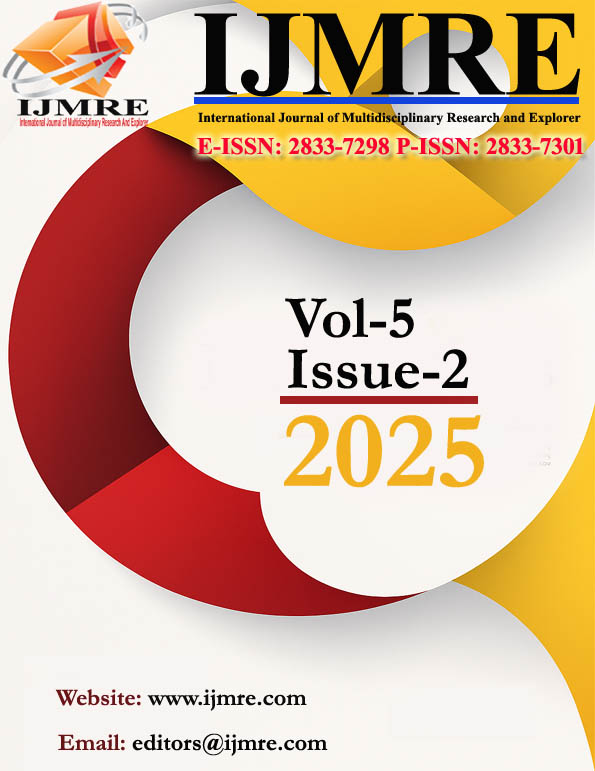SALES FORECASTING EFFECT ON PHARMACIES
DOI:
https://doi.org/10.70454/IJMRE.2025.50202Keywords:
ARIMA model, Linear regression, Naive Forecasting, Predictions, Sales ForecastingAbstract
Nowadays, as technology is advancing to previously unheard-of levels, every company and organization is finding it difficult to balance inventory and customer expectations. Every organization relies heavily on sales, and being able to predict the future helps in making strategic and intelligent sales decisions. The majority of businesses still struggle with revenue forecasting because it is usually the first step in developing the company's annual budget. Over time, a company's estimation could suffer if its sales projections are consistently inaccurate. Sales forecasting therefore affects the entire company to improve their overall growth strategy. An essential part of any business's sales operations is sale forecasting.
For a business to supply the necessary quantity at the appropriate time, an accurate sales forecast is essential. Executives use the predictions to assess future performance and plan for organizational expansion. In this study, we use the machine learning techniques of naive forecasting and linear regression to try and predict a retail company's sales. The difference between the linear regression and naïve forecasting approaches is demonstrated using a computational example, and we have found that the linear regression yields better results than the naïve forecasting approaches. Additionally, we used the ARIMA model for the linear regression approach to forecast the sales for the upcoming five days.
References
[1] G. E. P. Box and G. M. Jenkins, Time Series Analysis: Forecasting and Control, Holden-Day, 1976.
[2] S. Hochreiter and J. Schmidhuber, "Long Short-Term Memory," Neural Computation, vol. 9, no. 8, pp. 1735–1780, 1997.
[3] J. S. Armstrong, Principles of Forecasting: A Handbook for Researchers and Practitioners, Springer Science & Business Media, 2001.
[4] C. Chatfield, The Analysis of Time Series: An Introduction, CRC Press, 2003.
[5] M. Hyndman and G. Athanasopoulos, Forecasting: Principles and Practice, OTexts, 2018.
[6] T. Hastie, R. Tibshirani, and J. Friedman, The Elements of Statistical Learning, Springer, 2009.
[7] N. Taylor, "Sales forecasting in pharmaceutical supply chains: A machine learning approach," International Journal of Production Economics, vol. 183, pp. 190–202, 2017.
[8] V. Makridakis, S. Spiliotis, and L. Assimakopoulos, "Statistical and Machine Learning Forecasting Methods: Concerns and Ways Forward," PLOS ONE, vol. 13, no. 3, 2018.
[9] P. Goodwin, "The Holistic Approach to Forecasting Accuracy: Combining Judgment and Statistical Models," International Journal of Forecasting, vol. 29, no. 1, pp. 123–130, 2013.
[10] Y. Wang, W. Zhang, and A. Ghosh, "Deep Learning for Time Series Forecasting in Retail," IEEE Transactions on Industrial Informatics, vol. 15, no. 6, pp. 3703–3711, 2019.
[11] S. B. Roy, A. Basu, and R. Sen, "Time Series Forecasting using Hybrid ARIMA and LSTM Models," in Proc. of ICMLA, 2020.
[12] H. Min, "Artificial Intelligence in Supply Chain Management: Theory and Applications," International Journal of Logistics: Research and Applications, vol. 13, no. 1, pp. 13–39, 2010.
[13] J. Zhang, Y. Wu, and Z. Liu, "Sales Forecasting Using Machine Learning with Multiple Time Series Features," in Proc. of IEEE BigData, 2018.
[14] A. Bandara, D. Weerasinghe, and C. Hewage, "Demand Forecasting for Pharmaceutical Drugs Using Machine Learning Algorithms," Journal of Health Informatics, vol. 12, no. 2, 2020.
[15] S. Chopra and P. Meindl, Supply Chain Management: Strategy, Planning, and Operation, 6th ed., Pearson Education, 2015.
[16] G. Adhikari and R. Agrawal, "Sales Forecasting Using ARIMA and Machine Learning Models," International Journal of Computer Applications, vol. 175, no. 7, 2020.
[17] P. Li, Y. Liu, and X. Yu, "A Naive Bayes Forecasting Framework for Retail Demand," IEEE Access, vol. 8, pp. 108614–108623, 2020.
[18] Y. Chen, J. Li, and Z. Xu, "Pharmaceutical Inventory Optimization Using Predictive Analytics," Expert Systems with Applications, vol. 145, pp. 113–123, 2020.
[19] J. Brownlee, Introduction to Time Series Forecasting with Python, Machine Learning Mastery, 2018.
[20] R. Hyndman, "Forecasting Time Series with Exponential Smoothing and ARIMA," Journal of Statistical Software, vol. 27, no. 3, 2017.
[21] L. Yang, X. Sun, and B. Yu, "Combining Deep Learning and ARIMA for Sales Forecasting in Retail," Procedia Computer Science, vol. 162, pp. 206–215, 2019.
[22] T. Zhang, "Short-Term Sales Forecasting Based on Ensemble Learning," Journal of Intelligent & Fuzzy Systems, vol. 39, no. 4, pp. 5473–5483, 2020.
[23] A. Kumar and M. Singh, "Predictive Modelling in Health-Care Retail Analytics," Procedia Computer Science, vol. 173, pp. 220–227, 2020.
[24] P. Kumar and N. Kumar, "Comparative Analysis of Naive and Machine Learning Forecasting Models in Retail," IEEE ICCCNT, 2021.
[25] M. T. El-Masri, "Forecasting Pharmaceutical Sales using ARIMA Models: A Case Study in the MENA Region," Operations Research and Decisions, vol. 30, no. 2, pp. 89–101, 2020.
now acoording to refernces provided prepare introduction section by citng wherever necesaary
[26] Rakheja, P., Kumar Singh, R., & Kaur, A. (2025). Hybrid encryption and Riesz-based biometric authentication: a novel approach for secure greyscale image transmission. Journal of Modern Optics, 1–14. https://doi.org/10.1080/09500340.2025.2491582
[27] R. Bhakhar, R. Mandal, A. Goyal, A. Kumar, R. Singh and H. Vardhan, "Currency Detection Application for Visually Impaired People using Tensorflow Lite," 2024 13th International Conference on System Modeling & Advancement in Research Trends (SMART), Moradabad, India, 2024, pp. 450-455, doi: 10.1109/SMART63812.2024.10882163
[28] H. Vardhan, N. Sharma, M. Kumar, R. K. Singh, R. Mandal and I. Siraj, "Transforming Algorithmic Trading with AI: Achieving Competitive Market Edge," 2024 13th International Conference on System Modeling & Advancement in Research Trends (SMART), Moradabad, India, 2024, pp. 456-461, doi: 10.1109/SMART63812.2024.10882194
Downloads
Published
Issue
Section
License
Copyright (c) 2025 Dr. Manish Kumar (Author)

This work is licensed under a Creative Commons Attribution 4.0 International License.
This is an Open Access article distributed under the term's of the Creative Common Attribution 4.0 International License permitting all use, distribution, and reproduction in any medium, provided the work is properly cited.







